Pulmonary barotrauma can occur in a shallow swimming pool if a diver holds their breath during ascent or inadvertently floats to the surface while holding their breath. Most dive-related pulmonary barotraumas occur in compressed-gas diving due to pulmonary overinflation during a breath-hold ascent. Pulmonary barotrauma can occur even with normal breathing if there is an obstruction in the bronchial tree that prevents one lung segment’s normal ventilation.
Divers have become more susceptible to stings and other injuries when trying to grasp permanent mooring lines. Learn why this has become a problem and how to manage injuries.
Audible cues and signals can get your buddy’s attention, signal a group of divers or indicate a problem you can help address. Even though we may dive to escape the noise of everyday life, we need to pay attention to the sounds around us. Doing so could make your dive even more special because your buddy got your attention to see something remarkable — or you may even save a life.
When a disaster strikes, are you prepared? Whether a natural disaster like a hurricane strikes or the location is experiencing social turmoil, have plans ready so you know your next steps.
Nitrox has gone from being warily regarded to being the gas of choice in many dive operations. It is estimated that in the United States alone, divers make millions of dives each year while using nitrox. Read more about recent nitrox research.
Gas density is one of the unknown mechanisms on the forefront of hyperbaric research. In another decade we could have equipment that makes gas density a nonissue. For now we’re left to carefully mix our gases and learn all we can about human performance under pressure.
Diabetes is no longer a disqualifier for diving, but those with diabetes will need medical clearance to dive. However, dive instructors may need additional information to properly teach these individuals.
Lithium-ion batteries are very safe, and accidents are rare. These batteries are found in gadget — gaming systems, fancy cars, power tools and your dive computer. But how common are accidents? The best approach is accident prevention.
Drowning is not splashing about like you see in film and television. Learn the cues so you’re prepared next time you’re in the water.
Some first-stage scuba regulators have a shared low-pressure hub. Purging the second-stage regulator to release pressure from all hoses before disassembling gear causes gas in the other hoses to move backward toward the first stage. The gas could carry debris from the other low-pressure hoses and possibly through the first-stage regulator into the hose being used to vent the system. Performing regular maintenance, checking your hoses and noting any difficulty in breathing or inflation during your predive check should prevent hose degeneration from causing an underwater incident.



